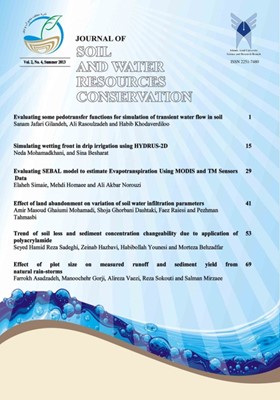Effect of land abandonment on variation of soil water infiltration parameters
Subject Areas : Farm water management with the aim of improving irrigation management indicatorsAmir Masoud Ghaiumi Mohamadi 1 , Shoja Ghorbani Dashtaki 2 * , Faez Raiesi 3 , Pezhman Tahmasbi 4
1 - M.Sc. student, Department of Soil Science, ShahreKord University, ShahreKord, Iran
2 - Assistant Professor, Department of Soil Science, ShahreKord University, ShahreKord, Iran
3 - Professor, Department of Soil Science, ShahreKord University, ShahreKord, Iran
4 - Assistant Professor, Department of Watershed, ShahreKord University, ShahreKord, Iran
Keywords: Hydraulic Conductivity, Infiltration, soil moisture pattern, wetting front,
Abstract :
Infiltration parameters are the most important indicators of soil quality. Soil water infiltration is one of the key properties for designing irrigation systems, hydrological studies, water resources management, drainage projects and soil conservation practices in watershed scale. The objective of this study was to investigate the effect of land abandonment on infiltration parameters in semi-stepped rangelands located in Karsanak, Chahar Mahal va Bakhtiari province, Iran. For this purpose, five types of land uses including pasture, agriculture, 3-5, 10-15 and 25 years-long abandonment were selected and the infiltrated water was measured in six replicates by tension infiltrometer apparatus. The results indicated that land use changing led to reduce soil organic matters, soil aggregate stability, soil pores connectivity and to disarranging soil natural pores. Consequently, the negative and significant effect of land use changing on parameters of water infiltration was deduced. Average saturated hydraulic conductivity in pastures (7.4 mm/h) was almost twice of that for agricultural land use (4.4 mm/h). In addition, the sorptivity experienced 30 percent reductions in agricultural lands compared to pastures. However, because of the land abandonment i.e. restoration of vegetation and macro aggregate formation and increasing aggregates stability, the infiltration process was improved such that saturated hydraulic conductivity of the 25 years-long abandonment improved from 4.38 to 6.09 mm/h.

